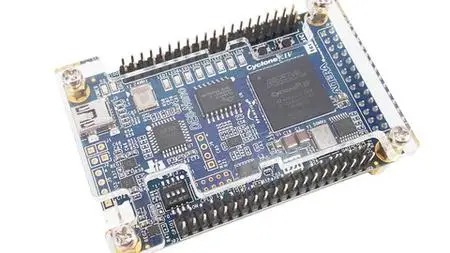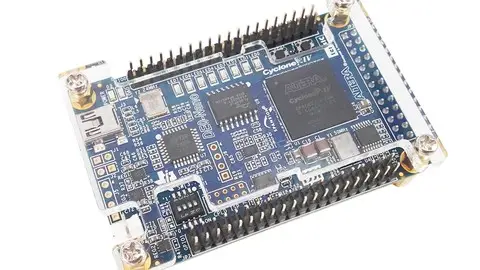Altera Fpgas: Learning Through Labs Using Vhdl
Last updated 5/2018
MP4 | Video: h264, 1280x720 | Audio: AAC, 44.1 KHz
Language: English | Size: 904.73 MB | Duration: 1h 59m
Last updated 5/2018
MP4 | Video: h264, 1280x720 | Audio: AAC, 44.1 KHz
Language: English | Size: 904.73 MB | Duration: 1h 59m
Grab your Altera FPGA development board and get a hands on approach to learning all about your FPGA through labs
What you'll learn
Understand the design process for implementing a digital design onto a FPGA
Program a FPGA
Replicate all the labs demonstrated in this lab
How to use the Altera development tools
Requirements
Purchase an Altera FPGA Development Board, we cover supported boards in the course
Basic understanding of binary notation
Basic understanding of hexadecimal notation
Basic understanding of logic gates
Basic understanding of VHDL
Description
Altera FPGAs: Learning Through Labs with VHDL teaches students digital design using the hands on approach. This course focuses on the actual VHDL implementation compared to the theory. The best most efficient way to learn VHDL is by actually writing and creating designs yourself. This courses includes 9 labs which include design for the following:
BCD DisplayRandom Number GeneratorSigned MultiplierBarrel ShifterArithmetic Logic UnitTemperature SensorTilt SensorMicrophone InterfacePotentiometer Interface
This course is structured such that each section contains a specific topic that is briefly discussed and then you will be given a design to start with to complete the lab. All the completed code solutions for each project will be available for download as a resource. Each section will contain a setup lecture that explains how to setup the lab. There is also a demonstration video given as a reference for a working design.
Overview
Section 1: Introduction to the Course
Lecture 1 Introduction
Lecture 2 Where should you buy your FPGA board?
Lecture 3 Lab Materials
Lecture 4 FPGA Board's Covered in this Course
Lecture 5 Which FPGA Board Are You Using?
Lecture 6 Course Structure
Section 2: Lab 1 - BCD Display
Lecture 7 BCD Display Explained
Lecture 8 BCD Display Assignment
Lecture 9 BCD Display Lab Setup
Lecture 10 DE0 Nano SOC Board - BCD Display Demonstration
Section 3: Lab 2 - Linear Feedback Shift Register
Lecture 11 Linear Feedback Shift Register Explained
Lecture 12 Linear Feedback Shift Register Assignment
Lecture 13 Linear Feedback Shift Register Lab Setup
Lecture 14 DE0 Nano SOC Board - LFSR Demonstration
Section 4: Lab 3 - Booth's Algorithm
Lecture 15 Booth's Algorithm Explained
Lecture 16 Booth's Algorithm Assignment
Lecture 17 Booth's Algorithm Lab Setup
Lecture 18 DE0 Nano SOC Board - Booth's Algorithm Demonstration
Section 5: Lab 4 - Barrel Shifter
Lecture 19 Barrel Shifter Explained
Lecture 20 Barrel Shifter Assignment
Lecture 21 Barrel Shifter Lab Setup
Lecture 22 DE0 Nano SOC Board - Barrel Shifter Demonstration
Section 6: Lab 5 - ALU (Arithmetic Logic Unit)
Lecture 23 ALU (Arithmetic Logic Unit) Explained
Lecture 24 Arithmetic Logic Unit Assignment
Lecture 25 ALU Lab Setup
Lecture 26 DE0 Nano SOC Board - ALU Demonstration
Section 7: Lab 6 - Temperature Sensor Interface
Lecture 27 Temperature Sensor Interface Explained
Lecture 28 Temperature Sensor Assignment
Lecture 29 Temperature Sensor Lab Setup
Lecture 30 DE0 Nano SOC Board - Temperature Sensor Demonstration
Section 8: Lab 7 - Tilt Sensor Interface
Lecture 31 Tilt Sensor Interface Explained
Lecture 32 Tilt Sensor Assignment
Lecture 33 Tilt Sensor Lab Setup
Lecture 34 DE0 Nano SOC Board - Tilt Sensor Demonstration
Section 9: Lab 8 - Microphone Interface
Lecture 35 Microphone Interface Explained
Lecture 36 Microphone Interface Assignment
Lecture 37 Microphone Interface Lab Setup
Lecture 38 DE0 Nano SOC Board - Microphone Demonstration
Section 10: Lab 9 - Potentiometer Interface
Lecture 39 Potentiometer Interface Explained
Lecture 40 Potentiometer Interface Assignment
Lecture 41 Potentiometer Interface Lab Setup
Lecture 42 DE0 Nano SOC Board - Potentiometer Demonstration
Section 11: Lecture Explained Notes
Lecture 43 ALU (Arithmetic Logic Unit) Explained Notes
Lecture 44 Barrel Shifter Explained Notes
Lecture 45 BCD Display Explained Notes
Lecture 46 Booth's Algorithm Explained Notes
Lecture 47 LCD Design Interface Explained Notes
Lecture 48 Linear Feedback Shift Register Explained Notes
Lecture 49 Microphone Interface Explained Notes
Lecture 50 Potentiometer Interface Explained Notes
Lecture 51 Temperature Sensor Interface Explained Notes
Lecture 52 Tilt Sensor Interface Explained Notes
Lecture 53 8-Bit ALU in VHDL Example
Lecture 54 16-Bit ALU in VHDL Example
Lecture 55 Display Decoder Example
Lecture 56 Booth's Algorithm Example and Link
Lecture 57 LCD 90s vs Today Example
Section 12: Conclusion
Lecture 58 Conclusion
Engineering Students,Engineering Managers,Digital Logic Enthusists,Individuals pursuing Electrical Engineering,Anyone who wants to learn more about VHDL,Anyone who wants to take it for fun!



